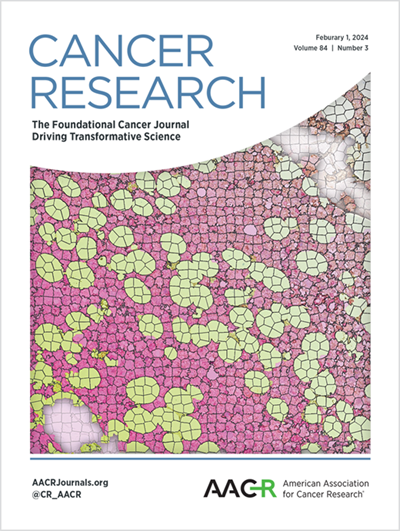Abstract P2-16-27: Risk factors of ipsilateral breast tumor recurrence in primary breast cancer patients who achieved pathological complete response after neoadjuvant chemotherapy
IF 12.5
1区 医学
Q1 ONCOLOGY
引用次数: 0
Abstract
Background: Pathologic complete response (pCR) is an early surrogate marker of long-term survival in human epidermal growth factor receptor 2-positive (HER2+) and triple negative breast cancer (TNBC). However, it is difficult to predict patients who should avoid breast-conserving therapy (BCT) even after achieving pCR by neoadjuvant chemotherapy (NAC) with respect to ipsilateral breast tumor recurrence (IBTR). We aimed to assess the risk of IBTR in pCR patients who underwent BCT after NAC. Patients and methods: We retrospectively reviewed clinicopathological characteristics of 178 TNBC or HER2+ primary breast cancer patients with pCR who underwent BCT after NAC in 2 institutes between 2002 and 2017. Histological type and grade were defined according to the World Health Organization classification system. Estrogen receptor (ER), progesterone receptor (PR), and HER2 status were determined from the surgical specimens. ER and PR were assessed by immunohistochemical staining. HER2 was considered positive if reported as 3+ on immunohistochemical staining or if those tumors reported as 2+ were amplified on fluorescence in situ hybridization (FISH). pCR was defined as no involvement of invasive ductal carcinoma in breast and lymph nodes. All patients who had node-positive before NAC had axillary lymph node dissection even if assessed as clinically node-negative after NAC (ycN0). The 5-year IBTR-free survival was estimated in each subtype. The risk factors of IBTR, including the age at diagnosis, clinical T-stage, clinical N-stage, histological grade, neoadjuvant regimen, pathological N-status, and postoperative chemotherapy, were estimated using the log-rank test for univariate analysis. P-values Citation Format: Naoko Matsuda, Naoki Hayashi, Ryu Tokui, Takahiro Nakayama, Hideko Yamauchi, Makoto Ishitobi. Risk factors of ipsilateral breast tumor recurrence in primary breast cancer patients who achieved pathological complete response after neoadjuvant chemotherapy [abstract]. In: Proceedings of the 2019 San Antonio Breast Cancer Symposium; 2019 Dec 10-14; San Antonio, TX. Philadelphia (PA): AACR; Cancer Res 2020;80(4 Suppl):Abstract nr P2-16-27.摘要P2-16-27:新辅助化疗后病理完全缓解的原发性乳腺癌患者同侧乳腺肿瘤复发的危险因素
背景:病理完全反应(pCR)是人类表皮生长因子受体2阳性(HER2+)和三阴性癌症(TNBC)长期生存的早期替代标志物。然而,对于同侧乳腺肿瘤复发(IBTR),即使在通过新辅助化疗(NAC)实现pCR后,也很难预测哪些患者应该避免保乳治疗(BCT)。我们旨在评估NAC后接受BCT的pCR患者发生IBTR的风险。患者和方法:我们回顾性回顾了2002年至2017年间在2个研究所接受NAC后接受BCT的178例TNBC或HER2+原发性癌症pCR患者的临床病理特征。组织学类型和级别根据世界卫生组织分类系统进行定义。从手术标本中测定雌激素受体(ER)、孕激素受体(PR)和HER2状态。ER和PR通过免疫组织化学染色进行评估。如果在免疫组织化学染色中报告为3+,或者如果在荧光原位杂交(FISH)中扩增那些报告为2+的肿瘤,则HER2被认为是阳性的。pCR被定义为不涉及乳腺和淋巴结的浸润性导管癌。所有在NAC前淋巴结阳性的患者都进行了腋窝淋巴结清扫,即使在NAC后被评估为临床淋巴结阴性(ycN0)。估计每种亚型的5年无IBTR生存率。IBTR的危险因素,包括诊断时的年龄、临床T分期、临床N分期、组织学分级、新辅助方案、病理N状态和术后化疗,使用单因素分析的对数秩检验进行估计。P值引文格式:松田直子、林直树、德井龙树、中山隆弘、山内秀子、石户部诚。新辅助化疗后病理完全缓解的原发性癌症患者同侧乳腺肿瘤复发的危险因素[摘要]。在:2019圣安东尼奥癌症研讨会论文集;2019年12月10日至14日;德克萨斯州圣安东尼奥。费城(PA):AACR;癌症研究2020;80(4增刊):摘要编号P2-16-27。
本文章由计算机程序翻译,如有差异,请以英文原文为准。
求助全文
约1分钟内获得全文
求助全文
来源期刊

Cancer research
医学-肿瘤学
CiteScore
16.10
自引率
0.90%
发文量
7677
审稿时长
2.5 months
期刊介绍:
Cancer Research, published by the American Association for Cancer Research (AACR), is a journal that focuses on impactful original studies, reviews, and opinion pieces relevant to the broad cancer research community. Manuscripts that present conceptual or technological advances leading to insights into cancer biology are particularly sought after. The journal also places emphasis on convergence science, which involves bridging multiple distinct areas of cancer research.
With primary subsections including Cancer Biology, Cancer Immunology, Cancer Metabolism and Molecular Mechanisms, Translational Cancer Biology, Cancer Landscapes, and Convergence Science, Cancer Research has a comprehensive scope. It is published twice a month and has one volume per year, with a print ISSN of 0008-5472 and an online ISSN of 1538-7445.
Cancer Research is abstracted and/or indexed in various databases and platforms, including BIOSIS Previews (R) Database, MEDLINE, Current Contents/Life Sciences, Current Contents/Clinical Medicine, Science Citation Index, Scopus, and Web of Science.
 求助内容:
求助内容: 应助结果提醒方式:
应助结果提醒方式:


